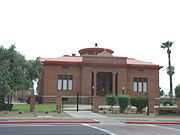List of Carnegie libraries in Arizona

Phoenix
Prescott
Tucson
Yuma
Arizona Carnegie libraries
The following list of Carnegie libraries in Arizona provides detailed information on United States Carnegie libraries in Arizona, where 4 libraries were built from 4 grants (totaling $64,000) awarded by the Carnegie Corporation of New York from 1899 to 1917.
Key
Building still operating as a library
Building standing, but now serving another purpose
Building listed on the National Register of Historic Places
Carnegie libraries
| Library | City or town |
Image | Date granted |
Grant amount |
Location | Notes | |
|---|---|---|---|---|---|---|---|
| 1 | Phoenix | Phoenix |  |
Apr 26, 1902 | $25,000 | 1101 W Washington St. 33°26′51.62″N 112°5′13.19″W / 33.4476722°N 112.0869972°W |
Closed after serving as the Phoenix Public Library from 1908 to 1953. Now the Carnegie Center, a multi-service center which includes the Arizona State Library.[1] |
| 2 | Prescott | Prescott |  |
Jul 4, 1899 | $4,000 | 125 E Gurley St. 34°32′30.02″N 112°28′3.32″W / 34.5416722°N 112.4675889°W |
Open from November 24, 1903 until 1975. The building is now home to several private businesses.[2] |
| 3 | Tucson | Tucson | Oct 27, 1899 | $25,000 | 200 S 6th Ave. 32°13′9.09″N 110°58′8.96″W / 32.2191917°N 110.9691556°W |
Served as the Tucson Public Library from 1901 to 1991. In 1991, it became the Tucson Children's Museum.[3] | |
| 4 | Yuma | Yuma | Sep 14, 1917 | $10,000 | 350 S 3rd Ave. 32°43′14.21″N 114°37′26.63″W / 32.7206139°N 114.6240639°W |
Opened February 24, 1921. Although heavily renovated in the 1950s, the original Carnegie library still stands as a branch library for the Yuma County Library District.[4] |
Notes
- ↑ "Carnegie Center". Retrieved 2009-06-21.
- ↑ Barks, Cindy (October 27, 2002). "Those were the days". The Daily Courier. Retrieved 2009-06-21.
- ↑ "Downtown Tucson Partnership > Culture > History". Retrieved 2009-06-21.
- ↑ "Library History". Yuma County Library District. Retrieved 2009-06-21.
References
- Bobinski, George S. (1969). Carnegie Libraries: Their History and Impact on American Public Library Development. Chicago: American Library Association. ISBN 0-8389-0022-4.
- Jones, Theodore (1997). Carnegie Libraries Across America. New York: John Wiley & Sons. ISBN 0-471-14422-3.
Note: The above references, while all authoritative, are not entirely mutually consistent. Some details of this list may have been drawn from one of the references (usually Jones) without support from the others. Reader discretion is advised.
| ||||||||||||||||||||||||||